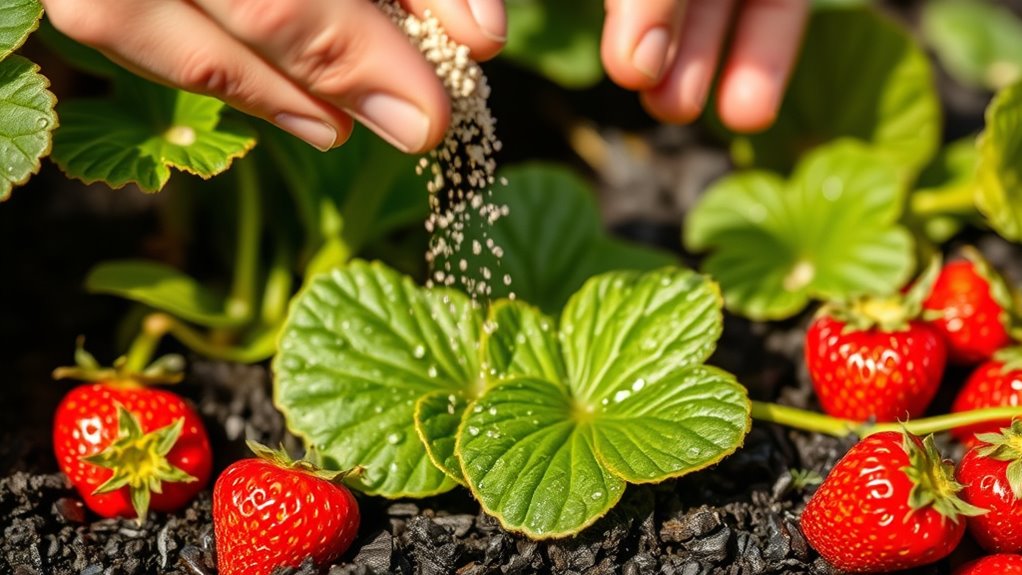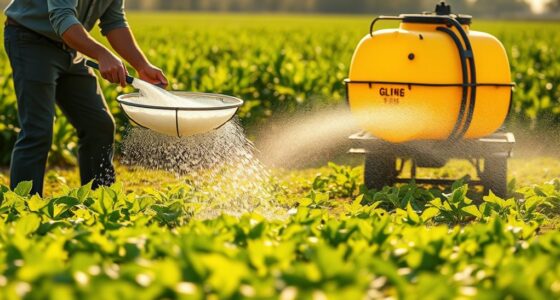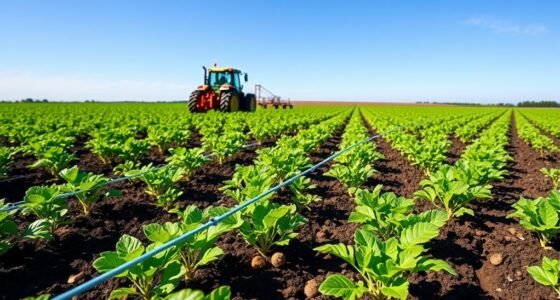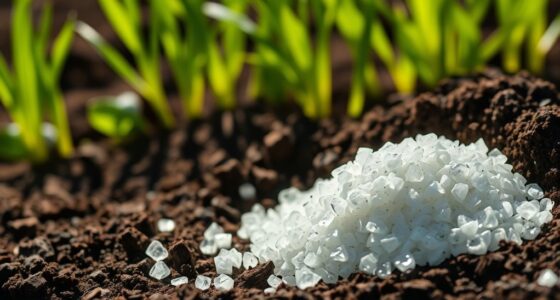To successfully fertilize leafy vegetables and strawberries, test your soil first to identify nutrient needs. Use nitrogen-rich organic feeds like compost and fish emulsion for leafy greens, and a balanced fertilizer for strawberries, applying early and every few weeks. Be careful not to overdo it, especially with nitrogen, to prevent pests and disease. Proper timing and even application help make certain of healthy growth and abundant harvests—keep exploring for more tips to optimize your feeding routine.
Key Takeaways
- Use nitrogen-rich fertilizers for leafy greens, applying early and every few weeks for lush foliage.
- Choose balanced fertilizers for strawberries to support roots, flowers, and fruit, fertilizing at planting and throughout the season.
- Conduct soil tests to identify nutrient deficiencies, and tailor fertilizer type and amount accordingly.
- Apply fertilizers evenly, keeping them away from plant crowns, and water thoroughly afterward to enhance absorption.
- Incorporate organic options like compost or seaweed to improve soil health and promote steady nutrient release.
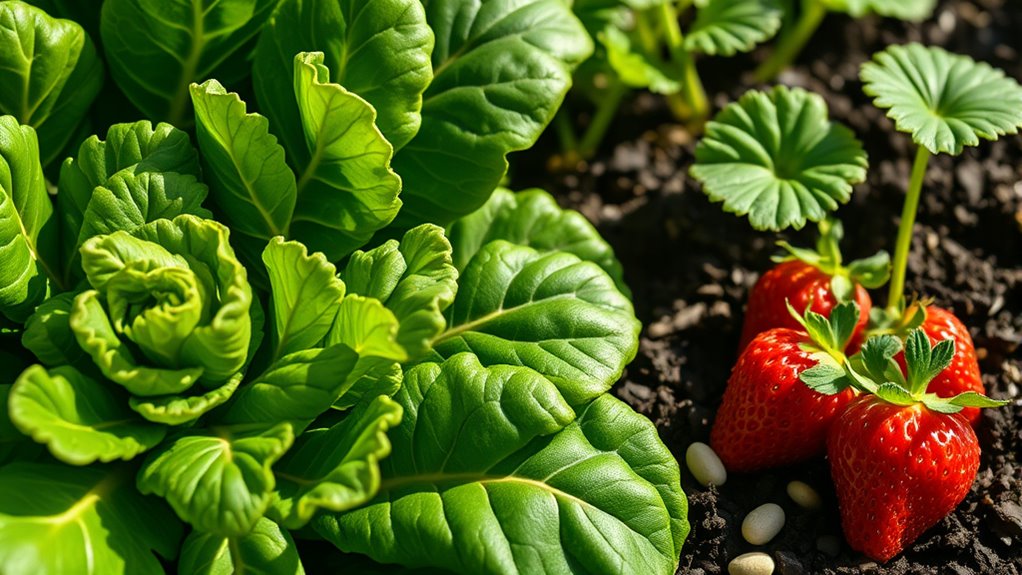
Fertilizing leafy vegetables and strawberries is essential for promoting healthy growth and maximizing yields. When you give your plants the right nutrients at the right time, you set the stage for vibrant, robust plants that produce abundant, flavorful leaves and berries. The key is understanding the specific needs of each crop and applying fertilizers thoughtfully. Leafy greens like lettuce, spinach, and kale thrive on nitrogen-rich feeds, which encourage lush, tender foliage. Strawberries, on the other hand, benefit from a balanced approach that supports root development, flowering, and fruiting.
To start, you should analyze your soil to determine its nutrient content. A simple soil test can reveal deficiencies or excesses, helping you choose the most appropriate fertilizer. If your soil lacks nitrogen, which is common in many garden beds, you’ll want to apply a fertilizer high in this nutrient. For leafy vegetables, a quick-release nitrogen fertilizer can give you rapid results, especially during the early stages of growth. For strawberries, a balanced fertilizer with equal parts nitrogen, phosphorus, and potassium works well, supporting overall plant health and fruit production.
Timing is critical when fertilizing. For leafy greens, apply fertilizer early in their growth cycle, then follow up every few weeks to maintain steady growth. Be careful not to overdo it, as excessive nitrogen can lead to overly lush foliage that’s prone to pests and diseases. For strawberries, fertilize at planting time to promote root establishment, then continue with light feedings throughout the growing season. Avoid heavy fertilization late in the season, as it can encourage weak, leggy growth that’s susceptible to winter damage.
When applying fertilizer, do so evenly across the bed, avoiding direct contact with the plant crowns to prevent rot. Organic options like compost, fish emulsion, or seaweed extracts can be excellent choices because they improve soil health and release nutrients gradually. If using synthetic fertilizers, follow the manufacturer’s instructions carefully to prevent overfeeding. Water your plants thoroughly after fertilizing to help nutrients penetrate the soil and reach the roots effectively. Incorporating soil health practices can further enhance nutrient availability and plant resilience.
Frequently Asked Questions
How Often Should I Fertilize Leafy Vegetables and Strawberries?
You should fertilize your leafy vegetables and strawberries regularly to keep them healthy and productive. For leafy greens, apply a balanced fertilizer every 2 to 3 weeks during the growing season. Strawberries benefit from fertilization about once a month with a fertilizer high in phosphorus and potassium. Always follow the product instructions, and consider supplementing with organic compost to boost soil nutrients naturally.
Can I Use Organic Fertilizers for Leafy Greens and Strawberries?
Yes, you can definitely use organic fertilizers for leafy greens and strawberries. Organic options like compost, manure, fish emulsion, and seaweed extract provide essential nutrients naturally. They improve soil health over time and reduce chemical buildup. Just guarantee you apply them according to instructions, and you’ll support healthy, vibrant plants. Organic fertilizers are a great choice to promote sustainable gardening and delicious, nutritious harvests.
What Signs Indicate Nutrient Deficiencies in These Plants?
When you notice yellowing leaves, it signals a nitrogen deficiency. If your strawberries have stunted growth or pale, poor fruit, they might lack potassium or phosphorus. Curling or browning leaf edges can indicate a calcium deficiency. Keep an eye on these signs, and if you see them, consider adjusting your fertilization routine. Proper nutrients support healthy growth and bountiful harvests for your leafy greens and strawberries.
Is There a Best Time of Day to Fertilize?
Did you know plants absorb nutrients most effectively early in the morning? You should fertilize your leafy vegetables and strawberries during the cooler parts of the day, like morning or late afternoon. This prevents the nutrients from evaporating quickly in the heat, ensuring better absorption. Avoid fertilizing during midday heat, as it can stress your plants. Consistent, thoughtful fertilizing helps your plants thrive and produce bountiful, healthy yields.
How Do Soil Types Affect Fertilization Strategies?
Soil types considerably influence your fertilization approach because they affect nutrient availability and retention. For instance, sandy soils drain quickly and may need more frequent feeding with soluble fertilizers, while clay soils retain nutrients longer and require less frequent, balanced feeding. Loamy soils are ideal, holding nutrients well. Adjust your fertilizer type, amount, and schedule based on your soil’s texture and composition to guarantee healthy, productive plants.
Conclusion
Think of fertilizing your leafy vegetables and strawberries as tending to a delicate dance. With the right nutrients, you’re guiding your plants to grow strong and vibrant, like a well-choreographed performance. Keep an eye on their needs, and don’t overdo it—balance is key. When you nurture them properly, you’ll enjoy lush, tasty harvests that reward your care, turning your garden into a thriving stage where nature’s beauty takes the spotlight.
